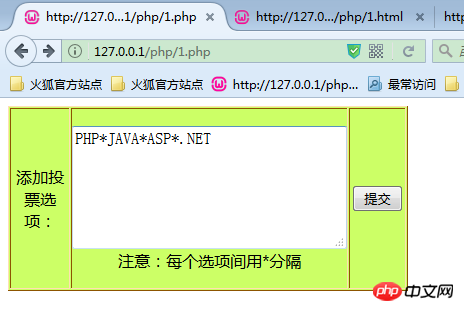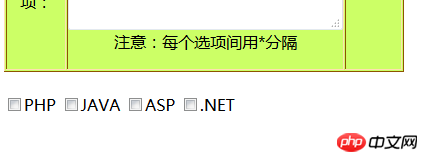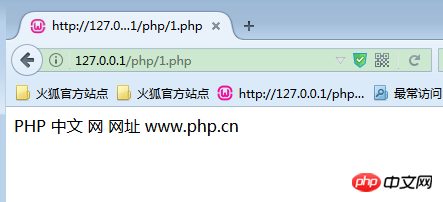PHP array and string conversion
Conversion of strings and arrays is often used in the process of program development. PHP mainly uses the explode() function and Implode() function implementation, we will explain it in detail below.
1. Use the explode() function to convert the string into an array
explode() function converts the string into an array according to the specified string or Character (separator) cut.
The syntax format is as follows;
array explode(string separator,string string [,int limit])
Returns an array composed of strings. Each array element is a substring of the specified string string. They are all divided by string separator as boundary points. Separate it. If the limit parameter is set, the returned array contains at most limit elements, and the last element will contain the remainder of the string; if the separator is an empty string (""), the explode() function will return false; if the separator contains The value of is not found in string, then the explode() function will return an array containing a single element of string; if the parameter limit is a negative number, all elements except the last limit element will be returned.
The following example uses the explode() function to separate the "PHP, Chinese, Internet" strings according to ",". The sample code is as follows:
<?php
header("Content-Type:text/html; charset=utf-8");
$str = "PHP、中文、網(wǎng)"; //定義一個(gè)字符串
$strs = explode("、","$str"); //應(yīng)用 explode()函數(shù)將字符串轉(zhuǎn)換成數(shù)組
print_r($strs); //輸出數(shù)組元素
?>The output result is:

When developing a voting management system, it is often necessary to add voting options to the voting system in the background as voting content. Next, use the explode() function to distinguish the added voting options with "*", and then use the white loop statement to output the added voting options in the page respectively.
The specific development steps are as follows:
(1) Use development tools to create a new PHP dynamic page and save it as index.php.
(2) Use HTML to mark the design surface, first create a voting form to add voting options, then use the each() function to extract the contents of the global array $_POST, and finally use a while loop to output the voting options content. The code is as follows:
<!DOCTYPE html>
<html>
<head>
<meta charset="UTF-8">
<title></title>
</head>
<body>
<!---------------------------------------------定義添加投票表單---------------------------------------------------->
<form name="form1" method="post" action="">
<table width="400" border="1" cellpadding="0" cellspacing="1" bordercolor="#FF9900" bgcolor="#CCFF66">
<tr>
<td width="98" height="120" >添加投票選項(xiàng):</td>
<td width="223" height="120"><p>
<textarea name="content" cols="30" rows="5" id="content"></textarea>
<br>
<span>注意:每個(gè)選項(xiàng)間用*分隔</span></p>
</td>
<td width="61" height="120">
<input type="submit" name="submit" value="提交">
</td>
</tr>
</table>
</form>
</body>
</html>(3) Add a table, and then add the following code in the cells of the table to output the added voting options.
<?php
if($_POST[Submit]!=""){
$content = $_POST[content];
$data = explode("*",$content);
while(list($name,$value)=each($data)){
echo '<input type="checkbox" name="checkbox" value="checkbox">';
echo $value."\n";
}
}
?>(4) Enter the address in the browser, press Enter, enter the content of the voting options, use "*" to separate each option, click "Submit", the running results are as follows


2. Use the implode() function to convert the array into a string
implode() function combines the contents of the array into a new string.
The syntax format is as follows:
string implode(string glue,array pieces)
The parameter glue is a string type, which refers to the separator to be passed in; the parameter piexes is an array type, which refers to the passed array variable name of the elements to be merged. .
Use the implode() function to connect the contents of the array with spaces as delimiters to form a new string. The specific example code is as follows:
<?php
header("Content-Type:text/html; charset=utf-8");
$str=array("PHP" ,"中文","網(wǎng)","網(wǎng)址","m.miracleart.cn");
echo implode(" ",$str); //以空格作為分隔符將數(shù)組中的元素組合成一個(gè)新的字符串
?>The output result is:

【Related tutorial recommendations】
1. Relevant topic recommendations: "php array (Array)"
The above is the detailed content of PHP array to string conversion. For more information, please follow other related articles on the PHP Chinese website!

Hot AI Tools

Undress AI Tool
Undress images for free

Undresser.AI Undress
AI-powered app for creating realistic nude photos

AI Clothes Remover
Online AI tool for removing clothes from photos.

Clothoff.io
AI clothes remover

Video Face Swap
Swap faces in any video effortlessly with our completely free AI face swap tool!

Hot Article

Hot Tools

Notepad++7.3.1
Easy-to-use and free code editor

SublimeText3 Chinese version
Chinese version, very easy to use

Zend Studio 13.0.1
Powerful PHP integrated development environment

Dreamweaver CS6
Visual web development tools

SublimeText3 Mac version
God-level code editing software (SublimeText3)

Hot Topics
 Why We Comment: A PHP Guide
Jul 15, 2025 am 02:48 AM
Why We Comment: A PHP Guide
Jul 15, 2025 am 02:48 AM
PHPhasthreecommentstyles://,#forsingle-lineand/.../formulti-line.Usecommentstoexplainwhycodeexists,notwhatitdoes.MarkTODO/FIXMEitemsanddisablecodetemporarilyduringdebugging.Avoidover-commentingsimplelogic.Writeconcise,grammaticallycorrectcommentsandu
 How to Install PHP on Windows
Jul 15, 2025 am 02:46 AM
How to Install PHP on Windows
Jul 15, 2025 am 02:46 AM
The key steps to install PHP on Windows include: 1. Download the appropriate PHP version and decompress it. It is recommended to use ThreadSafe version with Apache or NonThreadSafe version with Nginx; 2. Configure the php.ini file and rename php.ini-development or php.ini-production to php.ini; 3. Add the PHP path to the system environment variable Path for command line use; 4. Test whether PHP is installed successfully, execute php-v through the command line and run the built-in server to test the parsing capabilities; 5. If you use Apache, you need to configure P in httpd.conf
 PHP Syntax: The Basics
Jul 15, 2025 am 02:46 AM
PHP Syntax: The Basics
Jul 15, 2025 am 02:46 AM
The basic syntax of PHP includes four key points: 1. The PHP tag must be ended, and the use of complete tags is recommended; 2. Echo and print are commonly used for output content, among which echo supports multiple parameters and is more efficient; 3. The annotation methods include //, # and //, to improve code readability; 4. Each statement must end with a semicolon, and spaces and line breaks do not affect execution but affect readability. Mastering these basic rules can help write clear and stable PHP code.
 What is PHP and What is it Used For?
Jul 16, 2025 am 03:45 AM
What is PHP and What is it Used For?
Jul 16, 2025 am 03:45 AM
PHPisaserver-sidescriptinglanguageusedforwebdevelopment,especiallyfordynamicwebsitesandCMSplatformslikeWordPress.Itrunsontheserver,processesdata,interactswithdatabases,andsendsHTMLtobrowsers.Commonusesincludeuserauthentication,e-commerceplatforms,for
 PHP 8 Installation Guide
Jul 16, 2025 am 03:41 AM
PHP 8 Installation Guide
Jul 16, 2025 am 03:41 AM
The steps to install PHP8 on Ubuntu are: 1. Update the software package list; 2. Install PHP8 and basic components; 3. Check the version to confirm that the installation is successful; 4. Install additional modules as needed. Windows users can download and decompress the ZIP package, then modify the configuration file, enable extensions, and add the path to environment variables. macOS users recommend using Homebrew to install, and perform steps such as adding tap, installing PHP8, setting the default version and verifying the version. Although the installation methods are different under different systems, the process is clear, so you can choose the right method according to the purpose.
 Your First PHP Script: A Practical Introduction
Jul 16, 2025 am 03:42 AM
Your First PHP Script: A Practical Introduction
Jul 16, 2025 am 03:42 AM
How to start writing your first PHP script? First, set up the local development environment, install XAMPP/MAMP/LAMP, and use a text editor to understand the server's running principle. Secondly, create a file called hello.php, enter the basic code and run the test. Third, learn to use PHP and HTML to achieve dynamic content output. Finally, pay attention to common errors such as missing semicolons, citation issues, and file extension errors, and enable error reports for debugging.
 How Do You Handle File Operations (Reading/Writing) in PHP?
Jul 16, 2025 am 03:48 AM
How Do You Handle File Operations (Reading/Writing) in PHP?
Jul 16, 2025 am 03:48 AM
TohandlefileoperationsinPHP,useappropriatefunctionsandmodes.1.Toreadafile,usefile_get_contents()forsmallfilesorfgets()inaloopforline-by-lineprocessing.2.Towritetoafile,usefile_put_contents()forsimplewritesorappendingwiththeFILE_APPENDflag,orfwrite()w
 python if else example
Jul 15, 2025 am 02:55 AM
python if else example
Jul 15, 2025 am 02:55 AM
The key to writing Python's ifelse statements is to understand the logical structure and details. 1. The infrastructure is to execute a piece of code if conditions are established, otherwise the else part is executed, else is optional; 2. Multi-condition judgment is implemented with elif, and it is executed sequentially and stopped once it is met; 3. Nested if is used for further subdivision judgment, it is recommended not to exceed two layers; 4. A ternary expression can be used to replace simple ifelse in a simple scenario. Only by paying attention to indentation, conditional order and logical integrity can we write clear and stable judgment codes.






